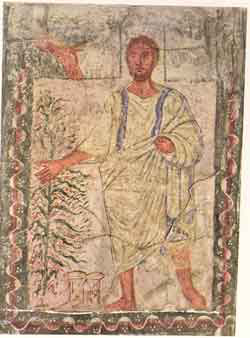Introduction
Where did things come from? How did things get started? Who made them? These are aetiological questions that fascinate humans of all cultures, times and ages. Most cultures have myths of origins—of themselves, their environment, their practices and institutions, of their world. One of the most widely-known stories of origins is the biblical account, found in the opening chapters of Genesis. The popular understanding of this account reads Creation as the serene work of a solitary and omnipotent God, who created the world out of nothingness by willing into existence all its components through the spoken word:
(ג) וַיֹּ֥אמֶר אֱלֹהִ֖ים יְהִ֣י א֑וֹר וַֽיְהִי־אֽוֹר׃
(3) God said, “Let there be light”; and there was light.
However, a close examination of Genesis 1 hints at alternate conceptions of Creation. For example, while light is created, neither water nor earth nor wind are created, but rather they are organized, limited, shaped.
This artistic process becomes explicit in Genesis 2:
(ז) וַיִּ֩יצֶר֩ יְהֹוָ֨ה אֱלֹהִ֜ים אֶת־הָֽאָדָ֗ם עָפָר֙ מִן־הָ֣אֲדָמָ֔ה וַיִּפַּ֥ח בְּאַפָּ֖יו נִשְׁמַ֣ת חַיִּ֑ים וַיְהִ֥י הָֽאָדָ֖ם לְנֶ֥פֶשׁ חַיָּֽה׃
(7) God יהוה formed the Human from the soil’s humus, blowing into his nostrils the breath of life: the Human became a living being.
(יט) וַיִּ֩צֶר֩ יְהֹוָ֨ה אֱלֹהִ֜ים מִן־הָֽאֲדָמָ֗ה כׇּל־חַיַּ֤ת הַשָּׂדֶה֙ וְאֵת֙ כׇּל־ע֣וֹף הַשָּׁמַ֔יִם וַיָּבֵא֙ אֶל־הָ֣אָדָ֔ם לִרְא֖וֹת מַה־יִּקְרָא־ל֑וֹ וְכֹל֩ אֲשֶׁ֨ר יִקְרָא־ל֧וֹ הָֽאָדָ֛ם נֶ֥פֶשׁ חַיָּ֖ה ה֥וּא שְׁמֽוֹ׃
(19) And God יהוה formed out of the earth all the wild beasts and all the birds of the sky, and brought them to the Human to see what he would call them; and whatever the Human called each living creature, that would be its name.
In other biblical passages, sculpture becomes architecture, as God measures and builds.
Genesis 1 also contains veiled references to mythical opponents of God, known from other accounts of Creation, both within and outside the Bible.
Such struggles with monsters, the third method of creation, are sometimes shocking:
(א) בַּיּ֣וֹם הַה֡וּא יִפְקֹ֣ד יְהֹוָה֩ בְּחַרְבּ֨וֹ הַקָּשָׁ֜ה וְהַגְּדוֹלָ֣ה וְהַחֲזָקָ֗ה עַ֤ל לִוְיָתָן֙ נָחָ֣שׁ בָּרִ֔חַ וְעַל֙ לִוְיָתָ֔ן נָחָ֖שׁ עֲקַלָּת֑וֹן וְהָרַ֥ג אֶת־הַתַּנִּ֖ין אֲשֶׁ֥ר בַּיָּֽם׃ {ס}
(1) In that day GOD will punishWith a great, cruel, mighty swordLeviathan the Elusive Serpent—Leviathan the Twisting Serpent;The Dragon of the sea will be slain.
Such overt references to Chaos monsters are also found in ancient Near Eastern mythology and help to explain strange allusions in Genesis 1, which we will discuss below.
Finally, a fourth mode of Creation emerges, as birth water issues from the womb of the Sea, as in God's speech out of the whirlwind in the book of Job:
(4) Where were you when I laid the earth’s foundations? Speak if you have understanding. (5) Do you know who fixed its dimensions Or who measured it with a line? (6) Onto what were its bases sunk? Who set its cornerstone (7) When the morning stars sang together And all the divine beings shouted for joy? (8) Who closed the sea behind doors When it gushed forth out of the womb, (9) When I clothed it in clouds, Swaddled it in dense clouds, (10) When I made breakers My limit for it, And set up its bar and doors, (11) And said, “You may come so far and no farther; Here your surging waves will stop”?
Verses 4 – 7 describe the creation as an act of divine architecture (similar to Genesis 2), while verses 8 and 9 describe it in terms of the birth process. In addition, words associated with struggle and battle ('boundaries,' 'bars' and 'doors,' etc) are used in verses 7 and 10 - 11, while this mythological adversary is stopped by divine speech in verse 11 (as in Genesis 1). Thus four different means of creation can be found in this powerful account; these same four means occur repeatedly throughout the Bible.
How have artists dealt with the different accounts of Creation? And how can we personalize these different conceptions?
Creation through speech/magic/language
Genesis 1 - 2
In the beginning….
1:3 God said, “Let there be light”; and there was light…
1:6 Then God said, “Let there be an expanse in the midst of the waters
1:9 Then God said, “Let the waters below the heavens be gathered
1:11 Then God said, “Let the earth sprout vegetation
1:14 Then God said, “Let there be lights
1:20 Then God said, “Let the waters teem
1:24 Then God said, “Let the earth bring forth living creatures
2:3 Then God blessed the seventh day and sanctified it
How does one visualize creation through the spoken word? Who in our world speaks and causes things to come into existence? In order to answer these questions, let's look at the art.
In Anton Koberger's illumination of his 1478 Bible, a fully anthropomorphic God appears at the top of the perimeter gesturing and speaking the world into existence (in the center, he builds Eve from Adam's body, by art, to be discussed below). In order to portray concretely the act of speaking, Koberger drew a bundle of lines emanating from God's mouth, directed into the heart of Creation.
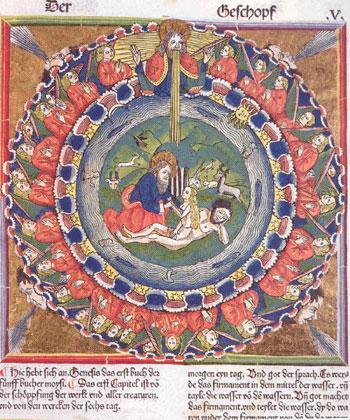
In Meister Bertram's Grabow altarpiece of a century earlier, gesture suffices to indicate speech.
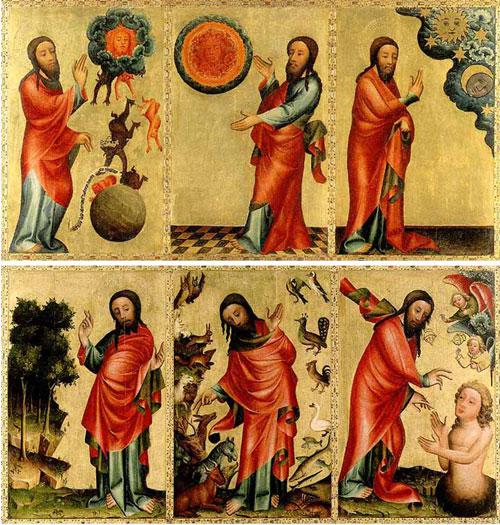
These gestures symbolize words. They look like magic; the magician, speaking Aramaic, says "Abracadabra" ('I create through speech', אברא כדברא) and lo and behold with a wave of the hand, no-thing becomes some-thing. Language creates reality. This view of Creation re-sounds through history, from the Hebrew Bible, to the New Testament (the logos, "In the beginning was the Word"), to healing through talk therapy, to post-modernist literary theory.
A particularly important use of speech in Creation is blessing, appearing three times in Genesis 1 - 2, which concludes with the blessing of the work of Creation:
(ג) וַיְבָ֤רֶךְ אֱלֹהִים֙ אֶת־י֣וֹם הַשְּׁבִיעִ֔י וַיְקַדֵּ֖שׁ אֹת֑וֹ כִּ֣י ב֤וֹ שָׁבַת֙ מִכׇּל־מְלַאכְתּ֔וֹ אֲשֶׁר־בָּרָ֥א אֱלֹהִ֖ים לַעֲשֽׂוֹת׃ {פ}
(3) And God blessed the seventh day and declared it holy—having ceased on it from all the work of creation that God had done.
A hyper-anthropomorphic illustration of these words is found in the Cathedral of San Marco in Venice:
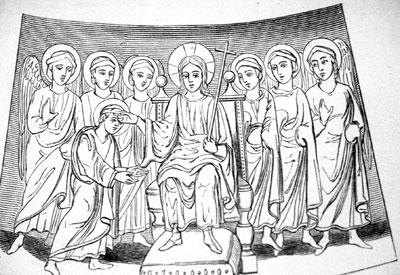
The six days of Creation, flank the enthroned God, who gestures in blessing the seventh day.
Thus, in these renditions, God speaks in two ways: 1) breathe emerging from God's mouth and 2) gestures visualizing the speech of Creation.
But, once spoken and heard the word is gone. To give it extended life in time, the word must be seen. Vision engages memory, so the word can endure. Words are encoded using pictures evolving into letters. Writing becomes another way of visualizing spoken language. Of course, the ultimate Writing, according to Jewish tradition, is the Torah. The very first midrash in Bereshit Rabba creates a dialogue between the figure of Divine Wisdom in Proverbs 8 and the first word of Genesis 1, בראשית (Not to be read "In the Beginning", but "Using Torah/Wisdom"). The midrash works as follows: In Proverbs, Wisdom claims that she was God's instrument in Creation:
(כב) יְֽהֹוָ֗ה קָ֭נָנִי רֵאשִׁ֣ית דַּרְכּ֑וֹ קֶ֖דֶם מִפְעָלָ֣יו מֵאָֽז׃
(22) “The LORD created me at the beginning of His courseAs the first of His works of old.
(ל) וָאֶהְיֶ֥ה אֶצְל֗וֹ אָ֫מ֥וֹן וָאֶהְיֶ֣ה שַׁ֭עֲשׁוּעִים י֤וֹם ׀ י֑וֹם מְשַׂחֶ֖קֶת לְפָנָ֣יו בְּכׇל־עֵֽת׃
(30) I was with Him as a confidant,A source of delight every day,Rejoicing before Him at all times,
The writing of Torah engenders the art of calligraphy. "Beautiful writing" is not just a coding system, but an expression of aesthetics and theology. For example, in Ben Shahn's Alphabet of Creation, black letters cluster in the divine womb, potential but not yet actual. The artist created this lithograph as part of his treatment of the Sefer Yetsira, an ancient mystical Jewish text.
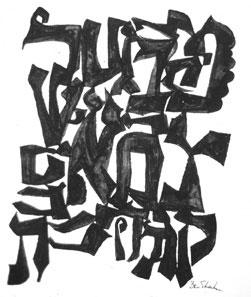
The womb itself is a vast white space, given form by the unarticulated letters. Theologically the white background is the presence of God, so bright we can see nothing until the scribe pens the black letters. God needs us, the scribes, in order to reveal a limited aspect of God's presence.
A passage from the Jerusalem Talmud describes the written Torah as black fire on white fire:
R. Pinchas said in the name of R. Simeon ben Lakish: The Torah
that the Holy One, blessed be He, gave Moses was white fire
inscribed with black fire. It is fire: mixed with fire, quarried from
fire, emanating from fire. Talmud Yerushalmi Shekalim 25b
Thus the black letters (black fire) give shape to the blinding light of God's presence, the white fire.
Abel Pann abstracted this idea, leaving only the ray of light.
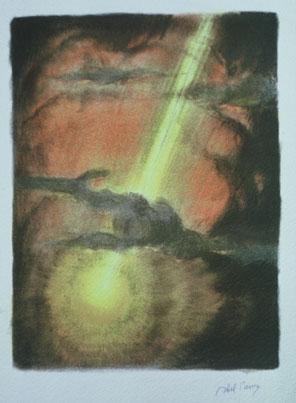
Abel Pann, He made the greater light, 1924
Even earlier, rather than a stream of light, Kabbalists drew Creation as a constellation of lights (the sephirot), the fundamental link between the spiritual world of God and the material world.

Portae Lucis - Latin translation of From Pardes Rimmonim, שערי אורה M. Gikatilla, Germany, Moses Cordovero, Cracow,
1516 1592
This constellation has the vague shape of a human body, often referred to as Adam Kadmon (the Primeval Man), but also identified as the characteristics of God. The sephirot can also take the shape of the letter Aleph, again integrating human shapes.
Kabbala unlocks the written Torah, which both contains the key to and is the process of Creation. The white space between letters, the absence of vowels and punctuation and the numerical values of the Hebrew letters create an ambiguity which explodes into phantasmagorical mystical creation.
Long before literature, long before the alphabet, long before language, there was the image. Aboriginal art from Australia is mainly concerned with Dream Time, the local version of the Creation story, which is past, present and future, Creation, Death and Rebirth.
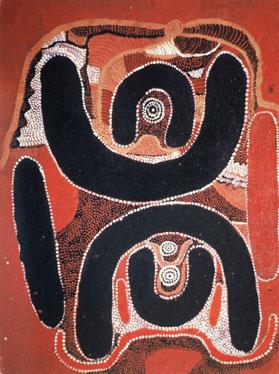
Old Mick Tjakamara,
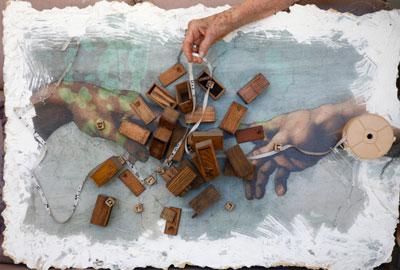
Jo Milgrom, Creation by language
"I doubt that Michelangelo knew the word midrash but that is what he painted on the Sistine ceiling: a visual commentary on the Bible. I have chosen a well-beloved fragment to build a midrash on a midrash: the famous hand of God enlivening the uncertain hand of Adam. In Genesis, ch. 2 God enlivens Adam with His breath. Earlier artists show a stream of air connecting God with Adam. Michelangelo challenges us to identify their invisible connection."
"In an estate sale I had bought a box containing twenty-two little boxes. Twenty-two is the number of letters in the Hebrew alphabet. Of course, God created by means of language: "Let there be…." Those little boxes plus a handful of Hebrew alphabet dice were randomly dropped on the poster and glued where they fell. So much for consonants. What about vowels and why were the vowels a separate element. The vowels appear on a white ribbon threaded through the boxes. The vowels, (breathe) said scholar Gershon Scholem, enable one to pronounce language. They are the spirit/wind of God in the very first verse of Genesis. The presence of God within language, Scholem continues, is a Jewish contribution to the science of linguistics."
"This interpretation of the famous Sistine hands enables us to understand the workings of the midrashic imagination in keeping the Bible endlessly contemporary."
Creation as Art and architecture
As outlined above, a second means of Creation appears in Genesis 2 and other biblical texts: Art. One of the most evocative examples of this concept is found in the words of the anonymous prophet of the Exile and Return:
(יב) מִֽי־מָדַ֨ד בְּשׇׁעֳל֜וֹ מַ֗יִם וְשָׁמַ֙יִם֙ בַּזֶּ֣רֶת תִּכֵּ֔ן וְכָ֥ל בַּשָּׁלִ֖שׁ עֲפַ֣ר הָאָ֑רֶץ וְשָׁקַ֤ל בַּפֶּ֙לֶס֙ הָרִ֔ים וּגְבָע֖וֹת בְּמֹאזְנָֽיִם׃
(12) Who measured the waters with a hand’s hollow,And gauged the skies with a span,And meted earth’s dust with a measure, And weighed the mountains with a scaleAnd the hills with a balance?
Medieval artists fascinated by the image of God the builder, repeatedly placed architects' tools in the hands of the Creator.
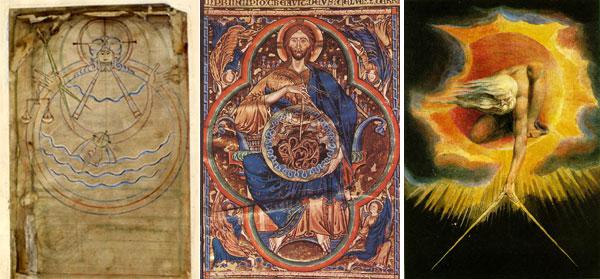
Creation, f. 7v God the Creator, The Ancient of Days,
ca. 1050 1252 - 70 1794
In the 11th century Tiberius Psalter, Genesis 1 is fused with Isaiah 40 into a schematic presentation of the Beginning. God is measuring the world's weight, volume and length using scales, a compass and other tools, while a dove ("the spirit of God") hovers above the waters. In the mid-13th century St. Louis Bible, God the Creator "encompasses" the world, positioned as God's womb. Within the world are darkness, formlessness, primeval waters and the four cardinal directions (Genesis 1:2), reflected in the page's corners, a microcosm within the macrocosm. The compass turns up again in the 19th century in the work of the romantic British artist/poet William Blake. An anthropomorphic Creator (Blake's Urizen, an emanation from the "true" God) emerges from the fiery Divine, directing the compass over the void and setting limits to the world.
Despite all the advances in science and our probing into space, we still think in terms of a three-tiered world, hard wired into our psyche: heaven, earth and the underworld. Our feet are on the earth, we look toward the heavens and speculate about what is beneath us. The diagram below maps out biblical references to this tripartite universe. The world is conceived here as a dwelling, with a roof to keep out the rain, a living area and foundations to support it. The Bible furnishes each of the three domains with components.
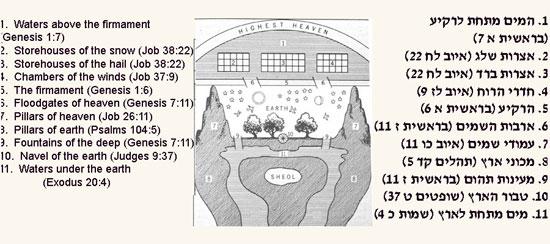
Biblical Conception of the World
Or as poetically summarized in Ginzberg's Legends of the Jews,
"The earth rests on pillars,
which rest on water,
which rests on mountains,
which rest on the winds,
which rest on storms,
which rest on God's arm."
This conception of the world as a dwelling created by God as architect underlies the opening to God's speech from out of the whirlwind in Job:
(ד) אֵיפֹ֣ה הָ֭יִיתָ בְּיׇסְדִי־אָ֑רֶץ הַ֝גֵּ֗ד אִם־יָדַ֥עְתָּ בִינָֽה׃ (ה) מִי־שָׂ֣ם מְ֭מַדֶּיהָ כִּ֣י תֵדָ֑ע א֤וֹ מִֽי־נָטָ֖ה עָלֶ֣יהָ קָּֽו׃ (ו) עַל־מָ֭ה אֲדָנֶ֣יהָ הׇטְבָּ֑עוּ א֥וֹ מִי־יָ֝רָ֗ה אֶ֣בֶן פִּנָּתָֽהּ׃
(4) Where were you when I laid the earth’s foundations?Speak if you have understanding. (5) Do you know who fixed its dimensionsOr who measured it with a line? (6) Onto what were its bases sunk?Who set its cornerstone
Another expression of God as artist, this time a potter, is found in Genesis 2:7, where God shapes Adam out of clods of earth, as literally detailed in this Byzantine ivory plaque. God seems to be reaching out to give final shape to the as yet incomplete Adam; at the same time, the intimacy between the two figures suggests the birth process.
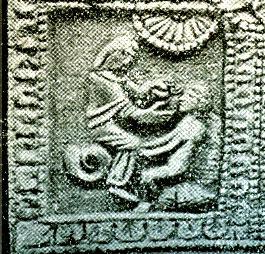
Byzantine Ivory, Creation of Adam, 10th -11th cent.
The great modern French sculptor, Auguste Rodin, became fascinated by the image of God the artist and late in his career, sculpted from marble several versions of God's hand creating humanity. Rodin separates himself both from the tradition of Genesis 1 in which God creates an androgynous being by His word and from the account of Genesis 2 in which man and woman are formed separately, man from the earth and women from the man. Here, the hand of God holds, as if in the womb, two intertwined figures. This is the work of a sculptor, reflecting on his life's work as creator in the image of God the Creator.
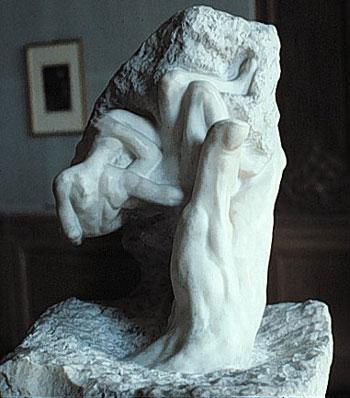
Four hundred years earlier, Michelangelo another creator out of the Earth, left behind an unfinished figure who seems to be in the process of emerging or awakening out of the stone – Michelangelo the artist imitates God the artist, who "rested from the work that he had yet to create" (Genesis 2:3).
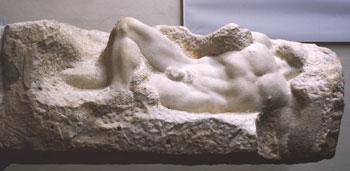
During work on Michelangelo's monumental painting of God creating Man, a photographer caught the silhouette of a restorer poised in imitatio dei, the imitation of God the Creator. The Hand of God or serendipity.
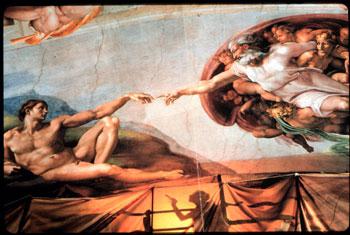
Restoration of Sistine Ceiling, 1989
Creation by struggle
Until the discovery of Babylonian epic literature in the 19th century, the account of Creation in Genesis 1 seemed to describe the effortless activity of an omnipotent God on inanimate and passive elements. The deciphering of the Enuma Elish, the Babylonian creation myth, has revealed a variety of linguistic and literary connections with Genesis 1, and has clarified that the Bible's bucolic account is really a polemic against the gross and violent conception of creation current in the great cultural center of Mesopotamia.
One of those seemingly passive elements of creation, the Hebrew tehom ("the deep", Genesis 1:2), turns out to be a cognate of the Babylonian Tiamat, the serpentine monster of the deep and primeval mother, who is vanquished by the god Marduk and sliced up to form the world. For the gory details, see Enuma Elish, Tablet IV, line 61ff.
The two illustrations below show how popular the Enuma Elish was in the ancient Near East. On a silver goblet discovered in the Palestinian village of Ein Samiyah, the two-headed Marduk confronts the snakelike Tiamat with poison plants; representing the next stage in the battle, he straddles her head, here represented as a rosette. To the right, two figures hold the arc of the sky, separating Tiamat's two halves and preventing chaos from returning.
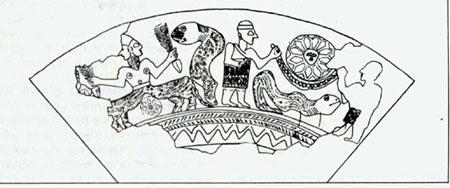
This epic battle between Marduk and Tiamat appears frequently as an emblem in ancient Mesopotamia, as in the cylinder seal below, showing the hero-god and his minions combating the chaos dragon.
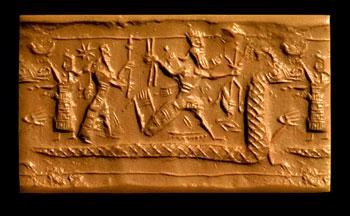
Tiamat is also associated with a cohort of monsters, named variously Tanin (cf. Genesis 1:21), Rahab (Isaiah 51:9) and Leviathan (Isaiah 27:1) or Lotan in the Ugaritic epics, as well as in other cultures of the ancient Near East. Tiamat has enjoyed a renaissance in modern times, used in the fantasy game Dungeons and Dragons and appearing frequently in pop culture. In the work of California artist, Judith Jones, her belly is ripped open to reveal the world:
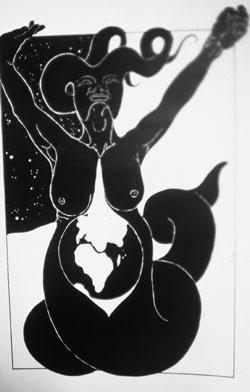
Judith Jones, Tiamat, ca. 1980
Note that it is the woman's body giving birth to the world. Thus procreation and struggle are combined in this image.
This violent account was suppressed in the Bible, in order to stress the God of Israel's effortless omnipotence and exclusivity. Yet, the monster turns up repeatedly, not only in hints within Genesis 1, but explicitly and furiously in Job 41, Isaiah 27 and Psalms 104.
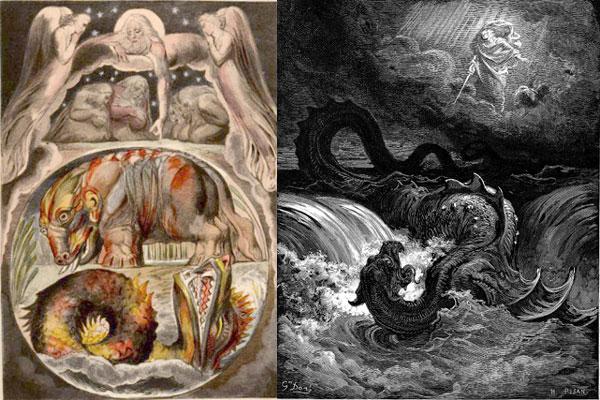
1823-26 1865
Nineteenth century artists William Blake and Gustave Dore each feature God alternately glorifying and subduing the sea serpent, Leviathan.
Nature photographer Ernst Haas captures the raw power of the sea and its effect on the coast, which may have originally produced myths of sea monsters. In order to create such a powerful image, Haas manipulated his photograph to produce a mirror image of the sea at the Gullfoss Falls, Iceland. The artist writes: "A sandwich photograph: a duplicate transparency placed in reverse over the original one, to produce the effect of divided waters" (Genesis 1:6; Creation, 1965)
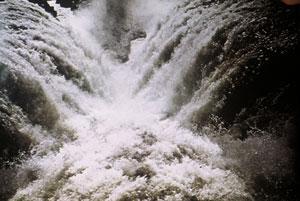
Ernst Haas, Let there be a firmament in the midst of the water,
1965
Thus far we have examined Creation by means of struggle in the Scripture and in the Ancient Near East. In our own day, Beth Ames Swartz also struggles/combats/destroys materials to create. In her Ten Sites Series, she revisited Israel to recreate Jewish women's stories associated with the sephirot and meqomot. In the process, she developed a technique of creation via destruction.
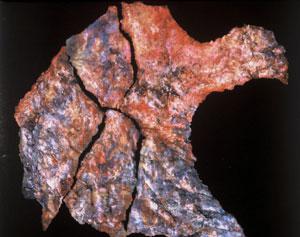
Beth Ames Swartz, Safed #1, 1981
One day I took a large piece of water color paper, scratched "fear
of dying" on it, ripped an opening in it with a screwdriver. I
wanted to get into it just like I had gotten into the mountains.
I scratched in potent words, mutilated the surface of the paper
and did the burning…I realized that somehow I was creating a
ritual.
Finally I was able to deal with the texture of the rocks.
Developing the fire process/ritual in 1976-77 allowed me to
literally get into the work – mutilating and burning the paper,
layering it, throwing paint on it and using the earth as pigment
– getting into the work as I had gotten into the landscape.
Israel Revisited, Beth Ames Swartz, May 1981, pp. 10 -11
Thus, through a struggle using fire, earth, sunlight and mixed media, Swartz assembles her materials into a collage sculpture in which the Hebrew letter Aleph is revealed in the negative space.
Creation by procreation/love
Sexual intercourse and birth are chief metaphors for creation in many ancient cultures, for natural reasons, but they are suppressed in the Bible, because Israel's God is beyond Nature and life processes. As a result, upstart biblical religion resisted the blatant sexual imagery of the surrounding cultures, especially Egypt and Mesopotamia.
But the power of these metaphors surfaces despite the tendency to suppress. Thus, in Genesis 1: 24-25, the creation of the land animals is described as:
Let the earth bring forth, each living creature after its kind –
cattle, and creeping things and beasts of the earth, after their
kind
It is as if the earth itself was giving birth to these creatures, in the same way that vegetation is described in v. 12: The earth brought forth vegetation…. In the picture below of a legendary beast (which is both animal and vegetable!) we see the Tartary lamb attached to a vertical umbilical cord emerging from Mother Earth.
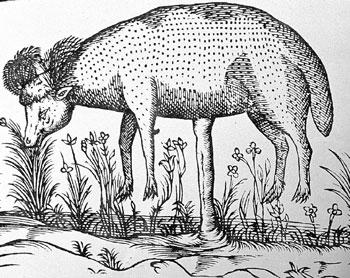
In addition, in Genesis 1:1-2, the five elements existing before the creation of light (unformedness, darkness, deep, breath and water) universally precede the process of birth; the word בראשית (from ראש = head) itself suggests the crowning of the head at birth. Likewise, in Job 38 the Sea springs out of the womb. In post-biblical times, these images blossomed in Jewish mysticism, commentary and liturgy, as in the proclamation of Rosh Hashana as היום הרת עולם - popularly translated "today is the birth day of the world", but more profoundly parsed as "time is forever birthing". Finally, returning to Genesis, we hear the refrain אלה תולדות ("these are the generations", literally "these are the birthings") – the first use of which regards Creation itself (Genesis 2:4).
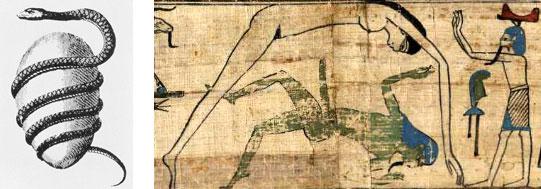
In many ancient cultures, the world is conceived as originally an egg-shaped unity. In the Orphic mysteries, Creation is a coiling serpent, symbolizing the inevitability of time. It cracks this unity into the duality of heaven and earth: God…separated the water above the firmament from the water below the firmament (Genesis 1: 7). Similarly, in the Egyptian painting above on the right, the feminine heavens (Nut) were once united with the fertilizing Father Earth (Geb), reflecting the same universal image as in the biblical statement:
(כד) עַל־כֵּן֙ יַֽעֲזׇב־אִ֔ישׁ אֶת־אָבִ֖יו וְאֶת־אִמּ֑וֹ וְדָבַ֣ק בְּאִשְׁתּ֔וֹ וְהָי֖וּ לְבָשָׂ֥ר אֶחָֽד׃
(24) Hence a man leaves his father and mother and clings to his wife, so that they become one flesh.
What does this cosmic egg look like on the inside? What is its meaning?
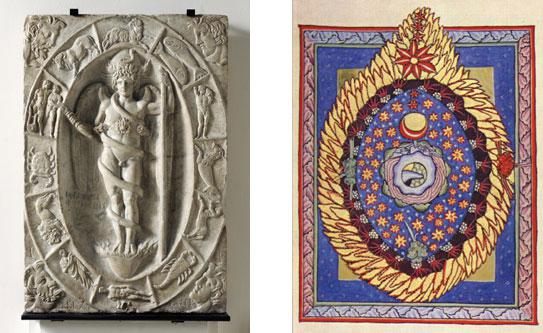
from the world egg, 2nd cent. The Universe,
1141-51
These two mandala images, from two entirely different cultural settings, present the inside story of the Cosmic egg. On the left, the Orphic god, Phanes (Light Bringer) appears within the egg, wrapped in the coils of the fertilizing serpent. The frame of the Zodiac, the half shell of the heavens, defines Time, while the four winds define Space. On the right, the same egg shape characterizes the Cosmos of Hildegard of Bingen, a twelfth century Christian mystic. Her imagery is based on the seven spheres of Aristotelian cosmology, morphed into ovals, and the Book of Revelation. Here too, time and space are present, in the faces of the four cardinal directions and in the sun, moon and stars. Both of these elliptical images can also be seen as openings into the conceiving and birthing womb.
Some of the same images appear in this European adaptation of Aboriginal art, an expression of the collective unconscious, in which the earth serpent (male) and the oval heavenly seed (female) unite in Creation.
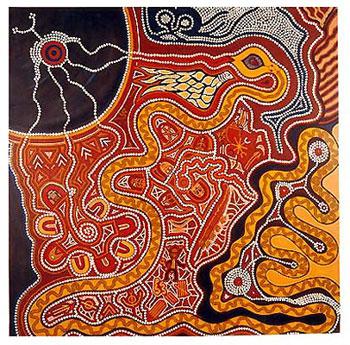
Lætitia d'Etiolles , "The Serpanterre and the Birth of Water"
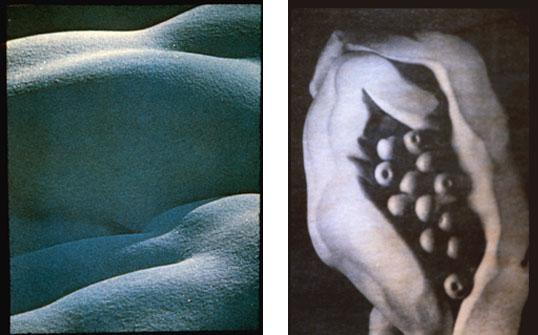
Ernst Haas, 1964 Cay Lang, American Body #21,
1989 -90
So, is it Mother Earth or Father Earth? On the left, in a photograph of Ernst Haas, smooth flowing contours of newly fallen snow over stones in a shallow river bed bear an astonishing resemblance to our parents, Mother and Father Earth. On the right, future parents embrace the fruit of their seed, echoing God's blessing of Man and Woman: "Be fruitful and multiply and fill the Earth" (Genesis 1:28)
In vitro baby Louise Brown, debuted in Time magazine on July 31, 1978. Here, in the womb of her mother Lesley, she bears an awe-inspiring likeness to the primeval being "Adam Kadmon", planted in the womb of the eternal "Ein Sof" three hundred years earlier.
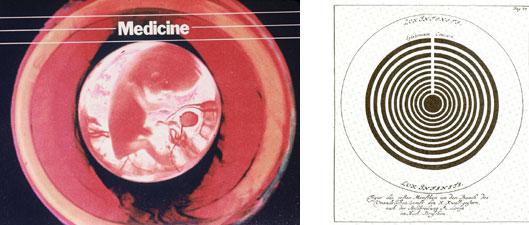
Time Magazine, Johan Georg Wachter
Test tube baby, Adam kadmon in the womb
July 31, 1978 of Ein Sof, 1699
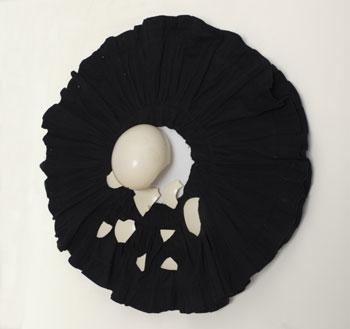
Jo Milgrom, Let There Be Light
A black skirt
encircles
the universe
From the
surprising
center
Fragments
of a gleaming
ostrich egg
anticipate
the light and fertility
of planet earth
There's no escaping the procreative archetype in Creation, from the Beginning to Now.
For additional images on this subject see TALI Visual Midrash



